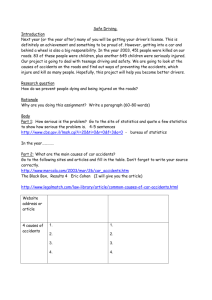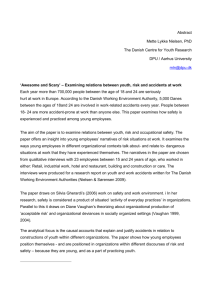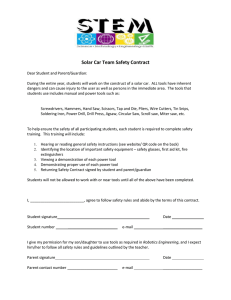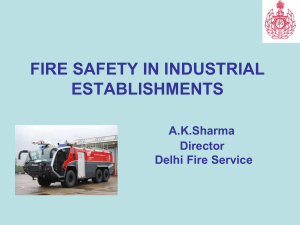~ JjO , V
advertisement
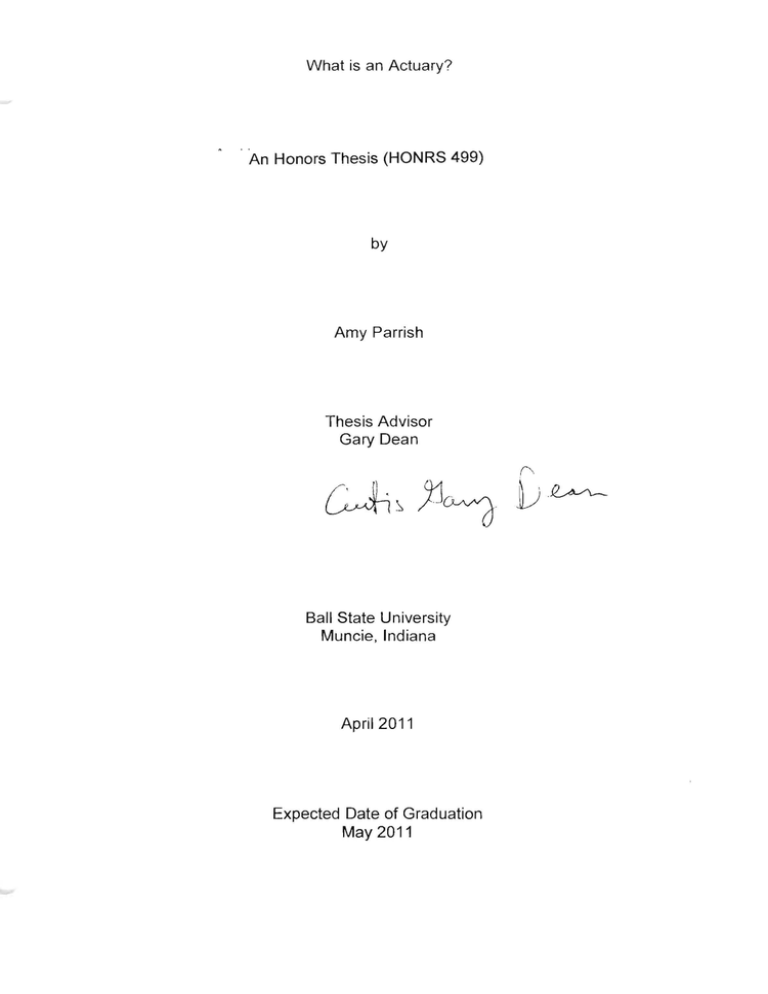
What is an Actuary?
, 'An Honors Thesis (HONRS 499)
by
Amy Parrish
Thesis Advisor
Gary Dean
!I'\
~ , JjO V · ~
Ball State University
Muncie, Indiana
April 2011
Expected Date of Graduation
May 2011
I
~,
I
Abstract
The career of an' actuary, although it is considered one of the best jobs in America, is relatively
unfamiliar to most people, especially high school students considering their options in Universities
and fields of study. Therefore, I have created an informative presentation about the actuarial
career which will introduce mathematically-minded high school students to the field of Actuarial
Science. I have also developed an insurance simulation which will help students understand
basic but essential actuarial methods in conditional probability and pricing based on past
experience
Acknowledgements
I would like to thank Mr. Gary Dean not only for advising me throughout this project but also for
unknowingly being an inspiration throughout my academic career at Ball State in my pursuit of a
career as an actuary. His encouraging attitude and critiques have helped me immensely in
developing my presentation.
I would also like to thank Mrs. Doris Givan for being instrumental in my formative mathematical
years and in helping me schedule my presentation with other high school teachers.
Finally, I would like to thank my roommates, my boyfriend and my parents for their patience and
encouragement as I finished my thesis.
Table of Contents
Page Number
Section
Author's Statement
Background
1
What is an Actuary?
1
Bayes'Theorem
1
I nsura nce Sim u lation
3
Conclusion
10
PowerPoint Presentation
11
Works Cited
16
Also Enclosed
I have also included a flash drive containing an electronic copy of my PowerPoint presentation and the
Insurance Simulation file.
Author's Statement
Background :
When I began considering various universities and fields of study during my senior year of high
school, I had no idea what I wanted to pursue. Luckily, my guidance counselor suggested Actuarial
Science, and, as I approach my graduation from Ball State, I cannot think of a major I would rather study.
However, one drawback I have found in my four years as an Actuarial Science major is that very few
people actually know what an actuary is . Therefore, I have decided to dedicate my senior thesis to
developing an informative and interactive presentation for high school students about the exciting and
rewarding field of Actuarial Science.
Presentation Part One: What is an Actuary?
I will begin my presentation with a short but informative PowerPoint presentation to get the
students interested in the actuarial field. My first slide, titled "What is the Best Job in America?" is
meant to catch the students' attention and foster interest in a field that they may have never heard of. I
will start by posing the question, "What is the best job in America?" After a few answers, I will reveal the
remainder of the slide, showing students that actuary has been consistently ranked as one of the top
jobs in America . Once the students are interested, I will continue with information about what actuaries
do, their average level of compensation, the hiring outlook for actuaries, and their work environment. A
copy of my introductory PowerPoint presentation is enclosed with information sources cited below each
slide, and an electronic copy is available on the enclosed flash drive.
Presentation Part Two: Bayes' Theorem
After we have briefly discussed what actuaries do, I will illustrate a theorem that is essential to
pricing and will help students understand the pricing simulation better. First, the students will need to
understand the following:
•
The reason pricing insurance is so challenging is that unlike other goods, the cost of insurance to
the company is unknown when the product is sold . If a company were to sell a tee-shirt, for
example, the company already knows how much all of the raw materials and labor cost and can
easily price the shirt to ensure a desired profit. However, because an insurance contract is not a
tangible good but instead a promise to pay in the event of a claim, the total cost can only be
estimated when the good is sold.
•
Actuaries have many methods of calculating the expected cost of an insurance policy. Generally,
a prospective insured person is rated on factors such as gender, age, driving record, and even
credit score so the insurance company can determine what type of driver the insured is likely to
be. This will tell the company how many accidents the prospective insured is expected to have,
therefore allowing actuaries to more accurately estimate the total cost of the policy. Historical
Authors Statement
data shows strong relationships between these rating factors and the safeness of the driver. For
example, males have historically been more dangerous drivers.
•
Bayes' Theorem is the essential link which allows actuaries to use historical data to determine
the probability of future events. It is used to calculate inverse probabilities. If the probability of
A given B is known and the probabilities of A and B are known as well, Bayes' Theorem allows
one to calculate the probability of B given A using the following relationship:
P B
r(
0) _ Pr :~; IB) '. Pr:B)
P i 0'
I..., -
r o...., )
Because I think Bayes' Theorem is most easily understood with a picture, I will draw the
following on the board to teach the students Bayes' Theorem:
30%
Fema le
55%
60%
70%
Male
45%
40%
Poor
Driver
Average
Driver
Good
Driver
1/4
1/2
1/4
As illustrated, an imaginary insurance company knows their distribution of drivers: one fourth
are poor drivers, half are average drivers, and one fourth are good drivers. Given the company's
historical data, the percentage males and females of each type of driver have been determined as
illustrated above. For the above insurance company, for example, of all insured persons who fell into the
"poor driver" category in the past, 70% were male, and 30% were female. Of all of the "good drivers" in
the past, 40% were male, and 60% were female. Using Bayes' Theorem, I will show students how to
calculate the probability that an insured is a poor driver, given that he is male. The probability that a
prospective insured will be a poor driver, given that he is male, can be found using the following
equation:
2
Author's Statement
.
Pr(Poor Dn;-qr\:'oJ'ale)
=Pr: .·;'.!ale[Poor Dh."e.
. .. ,Pr:Poor
. Dn;-er).
r) •
Pr:.'.Ia~ e)
So to calculate the probability that an insured is a bad driver given that he is male, we will
multiply the probability that an insured is a male given that he/she is a poor driver by the probability
that an insured is a poor driver. This product will then be divided by the overall probability that an
insured is male, giving us the following result:
Pr(Poo.r
,
Dn· ,-er[ ;'.}a~e)
=
.7· .25
--=-.5
Therefore, the probability that an insured will be a poor driver given that he is male is 35%. The
probability that he is an average driver is 45%, and the probability that he is a good driver is 20%. Using
this information, the insurance company can better estimate the expected cost of insurance for the
male driver and price his premium accordingly. After explaining this to the students, I will ask them to
calculate a few more probabilities, such as the probability that a future insured will be a good driver
given that she is female, to ensure they have grasped the concept of Bayes' Theorem.
Once students understand Bayes' Theorem and the idea of conditional probabilities, I will
explain that the practice of rating an insured on personal characteristics-as simplified in the previous
example-is used in more complex rating plans which take into account multiple characteristics to
calculate the expected cost, and later the required premium, for each individual insured.
Presentation Part Three: Insurance Simulation
Using Bayes' Theorem, I have constructed an insurance simulation which will teach students the
importance of rating based on experience. I will begin by handing out dice, which will represent the type
of driver of each student. I will consider rolling a six or higher having an accident. Therefore, the more
sides a student's die has, the higher their probability is of having an accident. There are four different
types of dice in my simulation: a standard six-sided die, which represents a good driver; an eight-sided
die, which represents an average driver; a ten-sided die, which represents a poor driver; and a twelvesided die, which represents a dangerous driver. If a six or higher is considered an accident, then with
each roll of the die, the probabilities of an accident for the six-, eight-, ten-, and twelve-sided dice are
.1667, .375, .5, and .583, respectively. Each student will choose a die at random, thus determining which
type of driver they will be for the experiment. Just as an insurance company knows its distribution of
drivers, I know the distribution of the dice I will hand out: .375 are six-sided, .125 are eight-sided, .375
are ten-sided, and .125 are twelve-sided. This distribution was simply chosen because I only had five of
the eight-sided and twelve-sided dice, and I wanted to make sure I had enough dice for forty students.
I included an electronic copy of my simulation on the enclosed flash drive for reference and to
show the calculations. My simulation will consist of three years. Each student will roll his or her die four
times to represent one year. The "worst drivers," students with twelve-sided dice, will experience more
accidents than the "best drivers," or students with six-sided dice. In the beginning, I will tell
3
Author's Statement
students that they all must pay the same amount for insurance, $1,500. Th is amount was chosen by
calculating the expected cost to the insurance company for each policy and rounding up to the nearest
multiple of 50. For each roll of a six-sided die, the probability of an accident is .1667. So for an entire
year, or four rolls of the six-sided die, the expected number of accidents is .1667*4 = .667 . Using the
same methodology, the expected number of accidents in one year for the eight-, ten-, and twelve -s ided
dice are 1.5, 2, and 2.333, respectively. To calculate the expected number of accidents for each student
without any knowledge of which die they hold, I will use the following equation:
Exp(Accidents)
= Exp(Accid entslDi e = 6) * Pr(Die = 6)
+ Exp(Accid entslDie = 8) * Pr(Die = 8)
+ Exp(AccidentslDie = 10) * Pr(Die = 10)
+ Exp(Accidents lDie
= 12) * Pr(Die = 12)
Therefore, the expected number of accidents for each student without having any information
about the die they hold is :
Exp(Accidents)
= (.667 * .375) + (1.5 * .125) + (2 * .375) + (2.333 * .125) = 1.479
For the sake of simplicity for this experiment, we will assume that each accident results in a
claim of $1,000 to the insurance company. Therefore, before any information is known about the die
each student holds, or the type of driver they are, the expected cost for each insurance policy is
$1,000* Expected Number of Accidents = $1,479, and each student's premium will be $1,500 for the first
year.
Next, each student will "drive" for one year (roll their die four times). After the first year of the
experiment, I will calculate the probabilities that each student is a dangerous driver, a poor driver, an
average driver, and a good driver given their number of accidents in year one using Bayes' Theorem. For
example, after the first year of "driving," if a student has had zero accidents, the probability that a
student is a "good driver" (has a six-sided die)) can be found using the following equation :
Pr(Die
Pr(Accidents = OlDie = 6) * Pr(Die = 6)
= 61Accidents = 0) = ------------:-----'------,--------'---~
Pr(Accidents
= 0)
The probability that a student has zero accidents in a year given that he/she has a six-sided die is
the product of the probability that each individual roll produces no accidents. Since a six or higher is
considered an accident, there is only a 1/6 chance that a student will have an accident with each roll,
and a 5/6 chance that a six-sided die will produce no accident. So the probability that a six-sided die will
produce zero accidents in one year (four rolls of the die) is:
555
Pr(Accidents
5
= OlDie = 6) = "6 * "6 * "6 * "6 = .4823
The probability of zero accidents given that the student holds an eight-, ten-, and twelve-sided
die will be calculated in the same way :
4
Author's Statement
Pr(Accidents
5
= OlDie = 8) = -
8
5
5 5 5
*- *- *8 8 8
5
5
= .1526
5
Pr(Accidents
= OlDie = 10) = 10 * 10 * 10 * 10 = .0625
Pr(Accidents
= OlDie = 12) = - * - * - * - = .0301
5
5
5
5
12
12
12
12
Then the overall probability that a student will experience zero accidents in one year is the sum
of the product of the probabilities that there will be zero accidents for each individual die and the
probability of that die.
Pr(Accidents = 0)
= Pr(Accidents
+ Pr(Accidents
+ Pr(Accidents
+ Pr(Accidents
Pr(Accidents
= OlDie = 6) * Pr(Die = 6)
= OlDie = 8) * Pr(Die = 8)
= OlDie = 10) * Pr(Die = 10)
= OlDie = 12) * Pr(Die = 12)
= 0) = (.4823 * .375) + (.1526 * .125) + (.0625 * .375) + (.0301 * .125)
Pr(Accidents = 0) = .2271
Finally, since the distribution of the dice is known, the probability that a student has a six-sided
die is known to be .375.
Pr(Die = 6) = .375
Now that each piece of the equation has been calculated, the probability that the student has a
six-sided die, given that he or she had zero accidents in the first year, can be found using Bayes'
Theorem:
Pr(Die
Pr(Accidents = OlDie = 6) * Pr(Die = 6)
= 61Accidents = 0) = - - - - - - - d , - - - - - - - - - Pr(Acci ents = 0)
Pr(Die
= 61Accidents = 0) =
.4823 * .375
.2271
= .7962
Given that a student has zero accidents, the probability that the student has each of the
remaining die is calculated using the same methodology as above. Calculations can be seen in the
simulation file.
Pr(Die
= 81Accidents = 0) =
PrCDie
= 61Accidents = 0) =
5
.1523 * .125
.2271
.0625 * .375
.2271
= .0840
= .1032
Author's Statement
Pr(Die
= 61Accidents = 0) =
.0301 * .125
.2271
= .0166
Clearly, if a student had zero accidents in the first year of driving, the probability that he or she
has a six-sided die is higher than originally expected when nothing was known about the student's die.
With the new probabilities for each die, I will re-calculate the expected number of accidents for each
student in the coming year. The equation used to calculate the expected number of accidents is the
same as before:
Exp(Accidents)
= Exp(AccidentslDie
+ Exp(AccidentslDie
+ Exp(AccidentslDie
+ Exp(AccidentslDie
= 6) * Pr(Die = 6)
= 8) * Pr(Die = 8)
= 10) * Pr(Die = 10)
= 12) * Pr(Die = 12)
The expected number of accidents for each die does not change. However, because I now have
one year of experience for each student, I know the different probabilities for each die. For a student
with zero accidents in year one, the expected number of accidents in year two is:
Exp(Accidents)
= (.667 * .7962) + (1.5 * .0840) + (2 * .1032) + (2.333 * .0166) = .9019
Assuming again that each accident will result in a claim of $1,000 to the insurance company, the
expected cost of an insurance policy issued to an individual who had zero accidents in year one is
$1,000* .9019 = $901.9. Rounding up to the nearest mUltiple of 50 again, the required premium to cover
expected losses for a student with zero accidents in year one is $950. Calculations of expected losses
and required premiums for a student with one, two, three, and four accidents-which are calculated
using the same methodology as above for a student with zero accidents-can be found in the sheet
labeled Bayes' Theorem in the simulation file.
I have designed the Experience sheet in my Excel simulation file to calculate the required
premium for year two using the formulas above and the number of accidents in year one. The premium
calculated using their experience will be lower for students with fewer accidents and higher for students
with more accidents. This is because students with less accidents in year one are more likely to have a
six- or eight-sided die and thus have less expected accidents and less estimated cost to the insurance
company. Students with more accidents in year one, on the other hand, are more likely to have dice
with ten or twelve sides and are thus more dangerous drivers with higher expected costs to the
insurance company. After giving the students their required premiums for year two, I will tell them they
now have a choice to make: Insurance Company A, the company which used their experience to rate
and price each student's insurance individually, and Insurance Company B. Insurance Company B is a
new company which was created to capture the disgruntled customers of Company A who are
dissatisfied with the increase in their rates. Assuming a higher flat rate than Insurance Company A
charged in year 1 will result in a better profit, Insurance Company B decides to charge a flat rate of
$1,800. I chose this rate so that students with three or four accidents in year one, whose premiums with
6
Author's Statement
Company A would be $2,000 and $2,100, respectively, would choose to switch to Company B. Students
who had two accidents in year one, whose premiums with Company A are $1,800 will be indifferent.
Finally, students with zero or one accidents in year one, whose premiums with Company A will be $950
and $1,350, respectively, will choose to stay with Company A.
After students have all chosen their insurance company for year two, they will "drive" tor
another year. Then, using both years of experience, I will calculate the probabilities that they are a
dangerous driver, a poor driver, an average driver, and a good driver once again using both years of
experience. Then I will re-price their insurance for year three based on what type of driver they are
expected to be (which die they are expected to have), which will tell me how many accidents they are
expected to have in year three and what is the expected cost to the insurance company. First, I will
need to calculate the probability that the student holds each die. Again using Bayes' Theorem, this time
with both years of experience, I will show how to calculate the probability that the student holds a sixsided die given that he or she has experienced zero accidents in years one and two.
.
Pr(Dte
.
= 61Acctdents = 0) =
Pr(Accidents
= OlDie = 6) * Pr(Die = 6)
P ('d
r Acct ents =
0)
The probability that a student has zero accidents in years one and two given that the student
has a six-sided die can be calculated by multiplying the probability that a student with a six-sided does
not roll a six or higher eight times .
Pr(Accidents
5 5 5 5 5 5 5 5
= OlDie = 6) = -6 * -6 * -6*6
- * - * - * - * - = .2326
6 6 6 6
Then the probability that a student has zero accidents given that the student holds an eight-,
ten-, and twelve-sided die can be calculated in the same way:
Pr(Accidents = OlDie
5 5 5 5 5 5 5 5
= 8) = -8* 8
- *8
- *8
- *8
- *8
- *8
-8
* - = .0233
5
5
5
5
5
5
5
5
5
5
5
5
5
5
5
5
Pr(Accidents
= OlDie = 10) = 10 * 10 * 10 * 10 * 10 * 10 * 10 * 10 = .0039
Pr(Accidents
= OlDie = 12) = -12 ** - * - * - * - * - *- = 0009
12 12 12 12 12 12 12 .
As before, the overall probability that a student experiences zero accidents in years one and two
can be calculated by multiplying the probability of zero accidents for each die in years one and two by
the probability that the student holds that die and summing for all four types of dice:
Pr(Accidents = 0)
= Pr(Accidents
= OlDie = 6) * Pr(Die = 6)
+ Pr(Accidents = OlDie = 8) * Pr(Die = 8)
+ Pr(Accidents = OlDie = 10) * Pr(Die = 10)
+ Pr(Accidents = OlDie = 12) * Pr(Die = 12)
7
Author's Statement
The distribution of dice remain the same, but the probability of zero accidents in years one and
two is different than the probability of zero accidents in year one alone. For two years of experience:
Pr(Accidents
= 0) = ('2326 * .375) + (.0233 * .125) + (.0039 * .375) + (.0009 * .125)
= 0) = .0917
Pr(Accidents
Again, because the distribution of dice has remained the same, the probability that the student
holds a six-sided die is the same as before:
Pr(Die
= 6) = .375
With all of the pieces of the equation calculated, the probability that the student holds a sixsided die given that he or she has experienced zero accidents can be calculated using Bayes' Theorem:
Pr(Die
= 61Accidents = 0) =
Pr(Die
Pr(Accidents
= OlDie = 6) * Pr(Die = 6)
P (A'd
r
= 61Accidents = 0) =
CCl
ents =
.2326 * .375
09
. 17
0)
= .9511
Using this same methodology, the probability that a student who has experienced zero
accidents holds an eight-, ten-, and twelve-sided die can be calculated:
Pr(Die
Pr(Die
= 81Accidents =
= 1 OIAccidents =
0)
:=:
0) =
Pr(Die = 121Accidents = 0) =
.0232 * .125
09
. 17
= .0317
.0039 * .375
.0917
= .0160
. 0009 * .125
0
= .0012
. 917
Clearly, after two years of experience, if a student has had zero accidents, the probability that
he or she holds a six-sided die is very high, and thus he or she is expected to be a good driver. I will
calculate the expected number of accidents in year three by multiplying the expected number of
accidents for each die by the probability that the student holds that die, given their experience in years
one and two.
Exp (Accidents)
= 6) * Pr(Die = 6)
+ Exp(AccidentslDie = 8) * Pr(Die = 8)
= Exp(AccidentslDie
+ Exp(AccidentslDie = 10) * Pr(Die = 10)
+ Exp(AccidentslDie = 12) * Pr(Die = 12)
8
Author's Statement
Then the expected number of accidents in year three for a student who had zero accidents in
years one and two will be:
Exp(Accidents) = (.667 * .9511)
+ (1.5 * .0317) + (2 * .0130) + (2.333 * .0012)
= .7165
Assuming a::;ain that each accident results in a $1,000 claim to the insurance company, the
expected cost of an insurance policy for a student who had zero accidents in years one and two is
.7165*1,000 = $716.5. Rounding up to the nearest multiple of 50, as before, the premium required in
year three for an insured who experienced zero accidents in years one and two is $750. The required
premiums for every possible combination of accidents in years one and two have been calculated in the
sheet labeled Bayes' Theorem in the simulation file. Again, I have designed the sheet labeled Experience
in the excel file to automatically calculate the required premium for year three after I input the students'
experience for years one and two.
After the first two years of driving, I will show the students the premiums they will be required
to pay with Company A for year three. Company B, after an unsuccessful first year with the flat rate of
$1,800 has decided to steal Company A's old rating plan, which only takes into consideration one year of
experience. Under Company B, students are given the option to pay the same premium for year three
that they would have paid under Company A for year two. Finally, Company C has been created and has
decided to offer a flat premium higher than Company B's to attempt to produce a profit. Company C will
charge $2,000 for all insurance policies. Students are once again given the choice between Companies A,
B, and C.
The best drivers who have experienced the fewest accidents will choose Company A, whose
experience rating and pricing allow them to get the lowest premium. Drivers who can benefit from only
using the first year of experience (for example, a driver who had zero accidents in year one but three
accidents in year two) will choose Company B. The worst drivers who experienced the most accidents
will choose Company C's flat-rate policy which is priced lower than their experience-rated policies at
both Companies A and B. Students will finally be asked to drive for one more year, and I will record their
number of accidents in year three.
After I have recorded all of the students' accidents for all three years, I will explain to the
students that insurance companies with the most accurate rating plans (in our experiment, Company A)
tend to attract better, less-risky customers because they offer the lowest rates to the best drivers.
Insurance companies which use out-of-date or less-accurate rating plans (Company B) will attract slightly
worse customers because worse drivers who can benefit from a rating plan which doesn't accurately
measure their higher risk will be attracted to such companies. Finally, companies that offer a flat rate
(Company C) will only attract the highest-risk, most dangerous customers because they are the only
ones who will benefit from the flat-rate insurance. Better customers who can get a lower premium with
another company will not buy insurance from a company offering a flat rate. Finally, I will show them
that because companies with less-accurate or flat-rate plans attract more risky drivers, they not only
have a more risky book of business, but they also have more costs to pay and thus less chance to make a
profit. In the Profit-Loss sheet in my Excel simulation file, I have calculated the profit and loss for
9
Author's Statement
Companies A, B, and C using the data the students provided by rolling the die. If a student chose
Company A for year two, for example, their premiums paid and loss from accidents were recorded on
the sheet labeled Insurance Company A, and profit or loss that student provided for the company wa s
calculated. Then the Profit-Loss sheet shows the total profit and/or loss for each company in all three
years.
Conclusion:
After giving my presentation, I am very happy with the re sult. Students asked questions about
the actuarial field throughout my PowerPoint presentation, and I think they all grasped Bayes' Theorem.
The simulation went smoothly, and the students seemed interested in the calculations behind it as well
as the general concept of experience rating. In the end, about a third of the class requested brochures
about Actuarial Science and more information about pursuing a career as an actuary. I definitely think I
met my goal of generating interest in the field as well as fostering a general understanding of basic
topics actuaries face on a daily basis. I hope the students who expressed interest in Actuarial Science will
pursue a degree in the field and be as happy with their decision as I am!
10
PowerPoint Presentation
What is an Actuary?
P. 1l Hon ors
rl"~~Ji(
my Pa rr i:.11
11
PowerPoint Presentation
What is the best job in America?
According to careerca sl.com, a site which annually ranks jobs in the United Slales: "
2009
1. Mathematician
2. Actuary
3. Statistician
2010
1. Actuary
2. Software Engineer
3. Computer Systems
Analyst
2011
1. Software Engineer
2. Mathematician
3. Actuary
According to the Jobs Rated Almanac:2
pt Edition (1988): 1
Edition (1999): 2
Edition (2000): 4
6th Edition (2002) : 2
4th
5 th
nd
2 Edition (1992): 2
3 rd Edition (1995): 1
Careercast ratings are based on stress level, physical demands, hiring outlook,
compensation and work environment. 1
12009, 2010, and 2011 data are taken from the following websites, respectively:
http://www.careercast.com/j obs-rated/10- best - iobs-2009,
http://www.careercast.com/jobs-rated/10-best -jobs-2010 , and
http://www.careercast .com/iobs-ra ted/lO- best -i obs- 20 11
2 Jobs
Rated Almanac ratings taken from the following website:
http://beana c t uary.com/a bout/best iob.cfm
12
PowerPoint Presentation
What is an Actuary?
Auudries analyze historical data ill orLiel w .'
Evaluate the likelihood of future events
Reduce the likelihood of undesirable events, when possible
Decrease the negative impact of undesirab le events that do
occur
Ways to Decrease and Manage the
Risk:
• Hurrica ne-specific construction
in hurricane areas;
homeowners insurance policy
Safe driving; car insurance
policy
• Healthy living; life insurance
policy
• In-depth retirement planning;
annuities
Examples of Undesirable Events:
House damage from hurricane
• Car accident
• Premature death of a family
member
• Insufficient retirement funds
3
This information, and additional information about the actuarial career can be found at:
http ://bea nactua ry.org/a bout/
Speaking notes:
Undesirable events are risks . One example of such a risk is the loss of your home due to a
hurricane .
Actuaries have models to evaluate the risk of such an event.
Although actuaries cannot prevent hurricanes, to prevent loss of home due to a hurricane, one
could refuse to build in a hurricane-prone area, which actuaries try to encourage by charging
high premiums in such areas. Hurricane-specific construction is also encouraged and sometimes
required for insurance. Premium discounts provide incentives for builders to invest in safer
construction in such areas.
Finally, in the event that a loss does occur, actuaries aim to decrease the negative impact of the
loss through insurance. If a home is completely damaged due to a storm, instead of having to
replace the home and the entire value of its contents, the insurance company will cover the loss
above the deductible.
Similarly, actuaries use historical data to evaluate the probability of other undesirable events
such as a car accident ofthe premature death of a family member. Safe driving and healthy
living, which are often encouraged through lower premiums for the insured, can prevent or
prolong such events. However, if such an event does occur, the insurance policies created by
actuaries are meant to decrease the negative financial impact.
Insufficient retirement funds is a risk that has been realized often in recent years . To prevent
this issue, careful retirement planning can be used, and actuaries can price financial instruments
such as annuities to allow retirees to receive lifelong benefits.
13
PowerPoint Presentation
Compen$ation
and Hiring Outlook
Actuaries are paid well for what they do. According to
DW Simpson Global Actuarial Recruitment, the average
st<Jrting wage for an <JctU<Jry is between $46,000 and
$65,000 .
Examples of exam and
experience sa lary
incentives can be found
The actuarial field is
challenging and
provides constant
opportunities for
advancement; most
companies offer a
salary increase with
each successive exam
passed.
here .4
According to the Bureau of Labor Statistics, empl oyment of actuaries
is expected to grow much faster than the average for all occupations
at about 21% over the 2008-2018 period.'
4http://dwsimpson.com/sa lary.html
5
http://www.bls.gov/oco/ocos041.htm#outlook
Note: the national average for all occupations is between 7 and 13%.
14
PowerPoint Presentation
Work Environment
Actuaries work desk joG,
little physical demands 6
Actuaries with e~~el , :;:1 ICC:
and broad knowl edge base
can advance to be Chief Risk
Officers or even Chief
Financial Officers of their
companie s
\N l ll)
The average work week for an actuary
is about 40 hours, though som e
con sulting jobs may require more
Advancement is always
possible and often
encouraged
6The information on this slide is taken from the Bureau of labor Statistics' website at
http://www.bls.gov/oco/ocos041 .htm#natu re
15
Works Cited
"Actuaries." Occupational Outlook Handbook, 2010-11 Edition. Web . 31 Mar 2011.
http://www.bls.gov/oco/ocos041 .htmlloutlook.
""Actuary" is Rated One of the Best Jobs in America!." Be an Actuary. Web . 29 Mar 2011.
http ://beanactuary .com/about/best job.cfm.
"Jobs Rated 2010: A Ranking of 200 Jobs From Best to Worst." CareerCast. Web. 28 Mar 2011.
http://www.careercast.com/j obs- rated/jobs-rated-2010-ra nki ng- 200- jobs-best-wo rst.
"The Ten Best Jobs of 2009." CareerCast. Web . 28 Mar 2011. http://www.careercast.com/jobs-rated/l0best-jobs-2009.
"The Ten Best Jobs of 2001." CareerCast. Web . 28 Mar 2011. http://www.careercast.com/jobs-rated/10best-jobs-2011.
"Updated Actuary Salary Surveys." OW Simpson. Web . 27 Mar 2011. http ://dwsimpson.com/salary.html.
"What is an Actuary?" Be an Actuary. Web . 29 Mar 2011. http://www.careercast.com/jobs-rated/l0best-jobs-2011.
16
